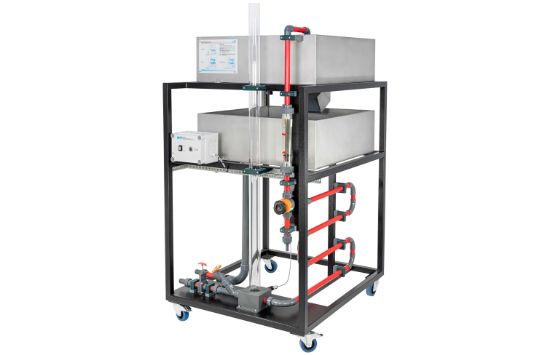Transient drainage processes are taken into consideration when deciding on the dimensions of storage reservoirs. The processes occur for example, in rainwater retention basins and storage lakes.
The main purpose of the rainwater retention basin is to delay the drainage process by temporary intermediate storage. Storage lakes are used in applications such as water supply, energy conversion, or in flood protection. The water rises before it is fed over an overflow.
The drainage processes from reservoirs is realised by pipelines, tunnels or other means. A surge chamber prevents water hammer in pipes and fittings in the event of rapid changes in flow rate.
HM 143 is used to demonstrate transient drainage processes from storage reservoirs and how a surge chamber works. The trainer includes a basin with adjustable weir and a second, deeper-lying basin with overflow and drainage line. A surge chamber is installed in the drainage line.
In the “rainwater retention basin” experiment basin A and basin B simulate retention basins. The discharge is adjusted by using valves in the drainage line. This illustrates typical delayed drainage processes.
In the experiment “storage lakes”, the transient drainage processes are shown in two long-term storage reservoirs. In this experiment the weir is used as a free overfall weir.
In the “surge chamber” experiment a water hammer is produced by rapidly closing a gate in the drainage line. The oscillation can be seen as pendulum movement of the water level in the surge chamber.
The water levels in the basins and at the surge chamber are detected by pressure sensors and displayed using the GUNT software.

Transient drainage processes in storage reservoirs
Transient drainage processes are taken into consideration when deciding on the dimensions of storage reservoirs. The processes occur for example, in rainwater retention basins and storage lakes.
The main purpose of the rainwater retention basin is to delay the drainage process by temporary intermediate storage. Storage lakes are used in applications such as water supply, energy conversion, or in flood protection. The water rises before it is fed over an overflow.
The drainage processes from reservoirs is realised by pipelines, tunnels or other means. A surge chamber prevents water hammer in pipes and fittings in the event of rapid changes in flow rate.
HM 143 is used to demonstrate transient drainage processes from storage reservoirs and how a surge chamber works. The trainer includes a basin with adjustable weir and a second, deeper-lying basin with overflow and drainage line. A surge chamber is installed in the drainage line.
In the “rainwater retention basin” experiment basin A and basin B simulate retention basins. The discharge is adjusted by using valves in the drainage line. This illustrates typical delayed drainage processes.
In the experiment “storage lakes”, the transient drainage processes are shown in two long-term storage reservoirs. In this experiment the weir is used as a free overfall weir.
In the “surge chamber” experiment a water hammer is produced by rapidly closing a gate in the drainage line. The oscillation can be seen as pendulum movement of the water level in the surge chamber.
The water levels in the basins and at the surge chamber are detected by pressure sensors and displayed using the GUNT software.
